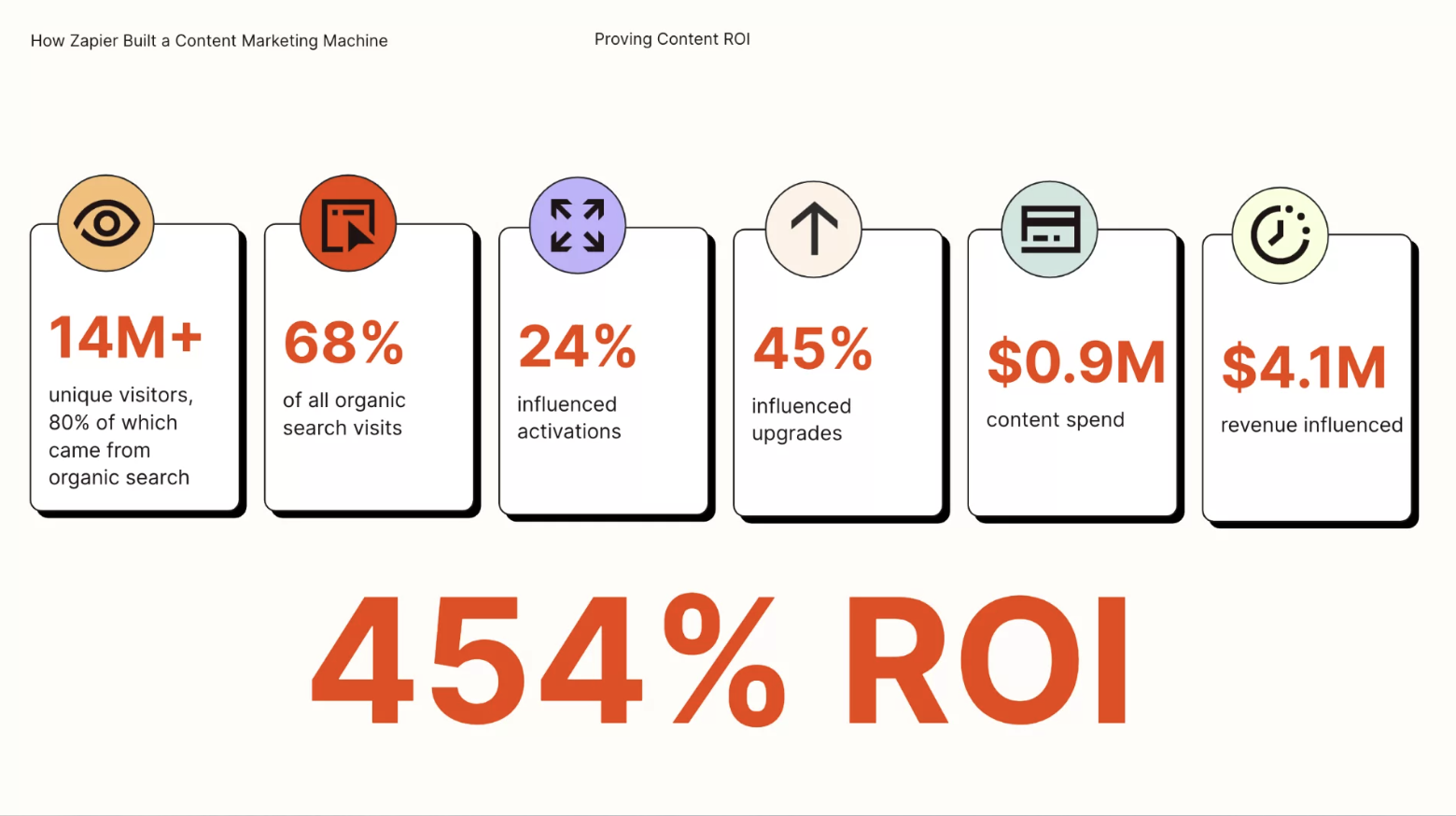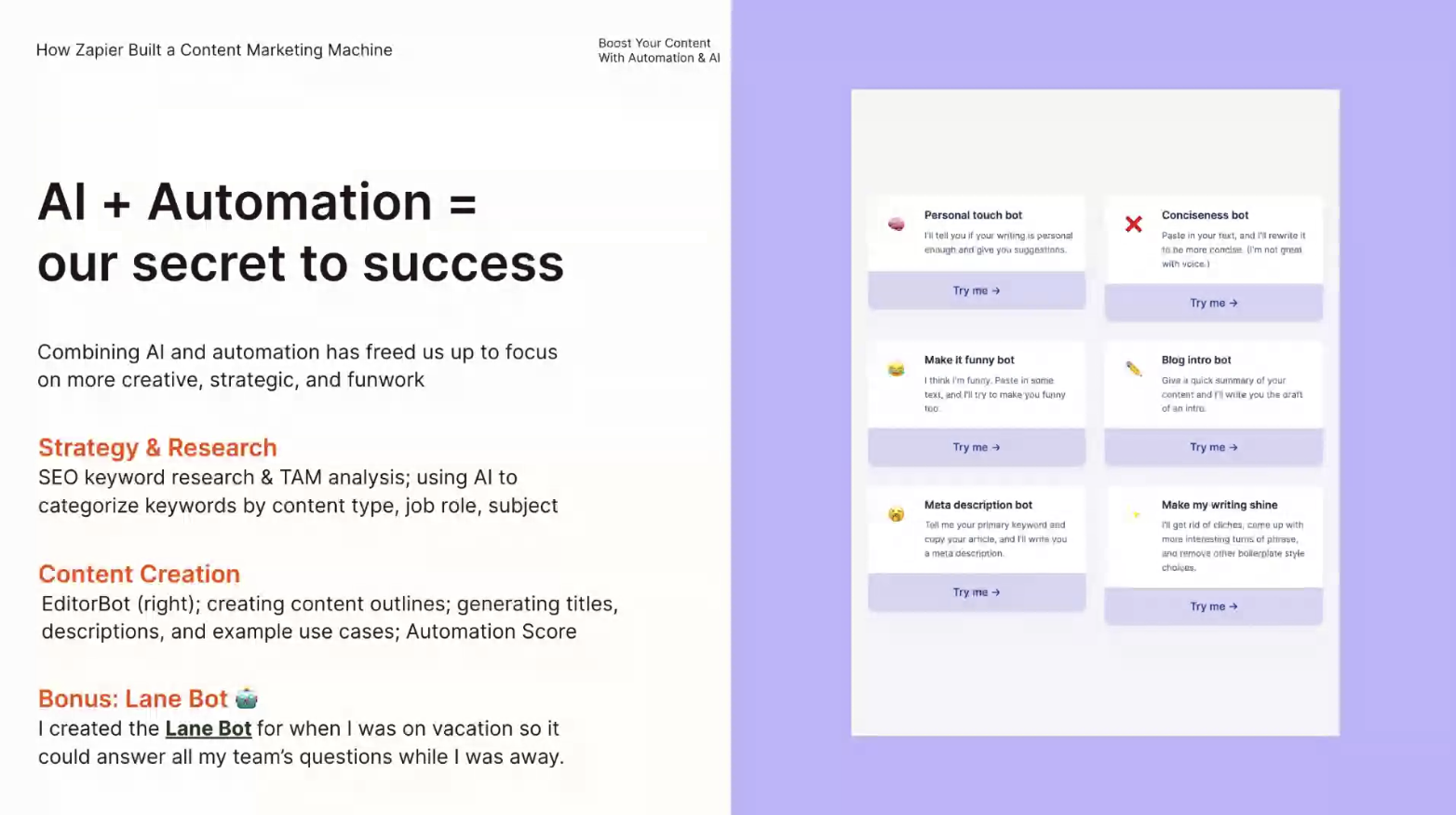When Lane Jones joined Zapier in 2021, she was immediately impressed at how the company has built a robust SEO program, creating landing pages for each integration and two service pages to explain their functionalities. This approach, combined with their collection of over 2000 high-quality articles, resulted in strong domain authority and attracted over 2 million monthly page views.
But Zapier's success was not solely due to SEO. Their content stood out with its unique voice, tone, and value, setting them apart from other B2B blogs in the industry. The blog was managed by just four people. But despite its size, the team consistently delivered great content.
One major advantage at Zapier was the genuine love people had for the product. Users expressed their admiration through tweets and other social channels, creating a positive foundation for the content team. However, despite strong traffic and sign-up numbers, the company faced a challenge: revenue growth seemed to stagnate.
The content team realized they had a leaky funnel and limited distribution channels. They were primarily relying on organic reach. Also, the content was often viewed as a service function, lacking a seat at the decision-making table. This prompted a shift in Lane Jones’ role, encouraging her to focus on proving the value of content to gain more resources and grow the team.
From Blog to Comprehensive Content Strategy
Initially known for its strong blog acquisition, Zapier expanded its content strategy to include mid-funnel programs, guiding the visitors to dive deeper into the content.
With significant blog traffic, Zapier focused on optimizing the onsite experience to encourage sign-ups. Content played a crucial role in guiding prospects, influencing their decisions, and driving conversions. It nurtured their interest, generated demand, and supported their journey through targeted campaigns. Content became the campaigns’ driving force.
Recognizing the importance of user education post-sign-up, Zapier established a dedicated user education team. Their program aimed to educate users and ease product adoption, ensuring customers make the most of the provided tools.
In the same way that content needs to go throughout the funnel, we wanted to see a team that represented the way that content fueled every part of the marketing journey. In 2021, it was four people, all focused on the blog. And today we've got 20 people.
To support this content strategy, Zapier grew its team. From a four-person blog-focused team in 2021, they expanded to 20 employees who represented the role of content throughout the marketing journey. This team included support campaign specialists and video marketing experts. There was also a strategy and ops team responsible for deriving insights from content data to inform content and company strategies.
Balancing Awareness, Activations, and Upgrades for High-Quality Outcomes
Zapier's marketing funnel operates in a distinct manner, focusing on awareness, sign-ups, activations, and upgrades. At the top of the funnel, the primary goal is to create awareness and drive sign-ups. Once users enter the product, the focus shifts to tracking activations (successful setup and usage) and upgrades (transitioning to paid plans or higher tiers). These metrics are closely monitored during weekly business reviews. Conversion rates for activations, upgrades, and revenue per user serve as indicators of success.
Balancing efforts between the top and mid-funnel poses an ongoing challenge. While top-of-the-funnel efforts yield impressive volume, mid-funnel efforts directly impact downstream metrics. Finding the right balance is crucial, especially when discussing outcomes with leaders and executives.
Zapier's Agile Marketing Team: Structure, Roles, and Expansion Opportunities
Zapier's marketing strategy is continually evolving, prioritizing adaptability. The current structure includes an editor overseeing the top-of-the-funnel initiatives, while writers contribute to various projects and continue supporting the blog. The campaigns team focuses on demand generation, lifecycle marketing, and product-related initiatives. Led by a content marketing manager, this team consists of two editors and five writers.
The video team, led by one team leader, includes two producers, while the user education team is managed by a program lead and supported by three learning designers. Lastly, the strategy and Ops team, consisting of one person, focuses on data analytics, vendor management, and capacity processing.
Zapier recognizes numerous opportunities for expansion, such as multimedia presence and growing its YouTube channel. Collaborating closely with the social team for short-form videos is an appealing area for investment.
We see a lot of opportunities too to expand into multimedia, grow our YouTube channel, to work closely with our social team on short-form videos. So that's another very compelling area of investment. Teams like user education and our campaign team are going to be the ones ultimately responsible for converting it.
Zapier's product and business model heavily relies on driving traffic and self-serve sign-ups. This self-service approach allows users to easily access and explore the product. Though, Zapier has also recently introduced a sales team, adding a new dimension to its business model.
Building Brand Awareness: Content Strategies for Long-Term Growth
Zapier employs two main methods to measure brand awareness. The brand marketing team conducts brand sentiment analysis and biannual surveys to obtain quantifiable measurements. As the content team, they use organic traffic and web traffic to specific pages as proxies for awareness. The top-of-funnel program drives the majority (around 70%) of Zapier's website traffic.
The content team is aware that this traffic may not consist of highly qualified leads who are ready to make immediate purchases. However, they still recognize the value of engaging this audience. By exposing them to Zapier's name and delivering valuable content, they are building awareness over time.
To capitalize on the growing interest in AI, Zapier has recently published content focused on AI and automation. It aims to educate readers on using AI to drive business growth. The "Best AI Image Generators" list caused up to a 50% increase in traffic during April. Although this audience may not be immediately inclined to purchase, the content team recognizes the long-term value of engaging them.
Demonstrating Content ROI with Concrete Numbers
To calculate ROI, Zapier’s team was using a performance marketing approach known as Return on Ad Spend. They analyzed not only the content budget but also considered estimations for headcount, technology, and data support. By mapping this investment against the actual returns, they aimed to measure the true value of their content strategy.
The revelation was astonishing. With a content spending of just under a million dollars in 2022, they discovered that their efforts had influenced over $4 million in revenue. This achievement translated into 454% ROI from content. After scrutinizing the numbers and collaborating with their data science team, they were amazed by the success.

The team was reassured by the high traffic and organic search percentages, showing their content's effectiveness. They presented the ROI figures to their CMO, who responded with enthusiasm, "Tell me why I shouldn't give you advertising's entire budget right now."
What truly mattered was that their data-driven approach demonstrated the value of content to the CMO and the entire organization.
When we put these numbers together, we were shocked by what we discovered, which is that with a little bit less than a million dollars in content spending for 2022, we influenced a little over $4 million in revenue, which gave us a 454% ROI from Content. We ran the numbers many times. We worked with our data science team because we knew it was good, but we didn't know it was delivering at that level.
To enhance their ROI evaluation, the team used budget and headcount apps for comprehensive resource monitoring and management. The alignment between the investment in their content program and the revenue it generated made the decision to allocate funds an effortless one for the CMO.
Maximizing Content Potential with AI and Automation
The content team at Zapier uses the power of AI and automation to overcome limitations and improve their content program. With the advanced technologies, they have found practical ways to work more efficiently and allow content creators to concentrate on important tasks.
AI has played a vital role in strategy and research. The SEO team used AI to categorize a large number of keywords in a recent total addressable market analysis. This new approach greatly saved time and effort, providing valuable insights more quickly.
One of the areas that we've just implemented over the past few months is using AI for strategy and research. We just did this total addressable market analysis that was led by our SEO team, and they used AI to take the massive amount of keywords and do the work of categorizing them by things that matter to us as a business. It cut down dramatically on the amount of time and manual work that our SEO team would have had to do and gave us insights more quickly.
Lane Jones created a bot that automatically reviews and edits content requests from different teams. This ensures brand consistency. AI has been employed to generate content outlines, titles, and SEO descriptions to improve productivity and accuracy. Also, writers at Zapier developed a bot that provides fictional use cases and customer stories. The bot integrates these examples into educational and mid-funnel content.

The Lane bot has been a notable addition. Trained to handle marketing and content strategy queries, it supported the team in the absence of a key leader.
Lane Jones mentioned that creating the bot was easy using Zapier's ChatGPT interface. This user-friendly tool enabled content creators to quickly add intelligence to their bots.
According to Zapier’s Head of Content, it is important to reassure writers that AI and automation are not threats to their roles. On the contrary, these technologies serve to enhance their work, freeing them to focus on creative and strategic tasks.
The fastest way to build digital experiences. We empower businesses to convert PDFs, presentations and other content into interactive experiences & webpages with instant branding, analytics & more




